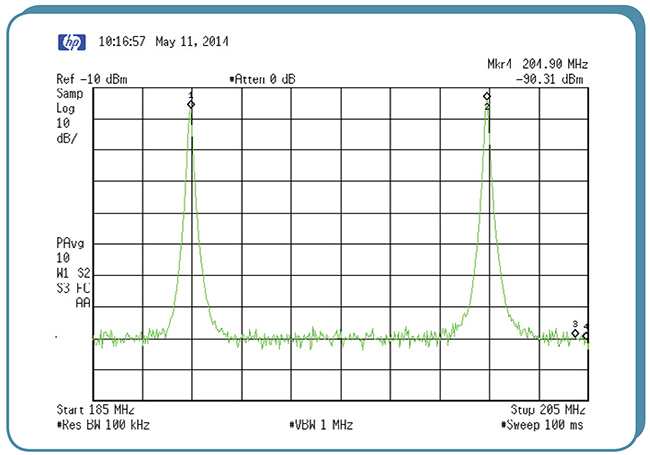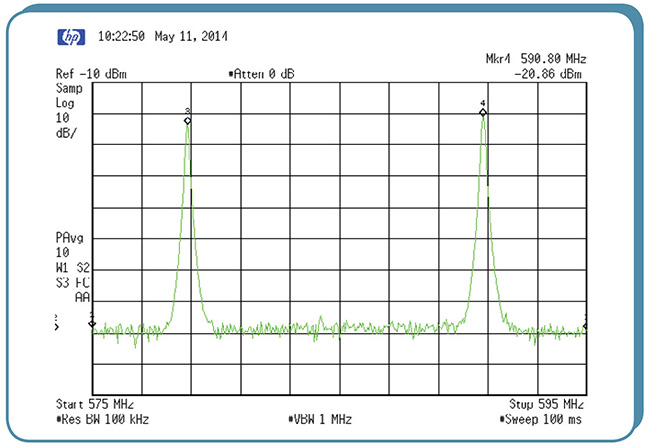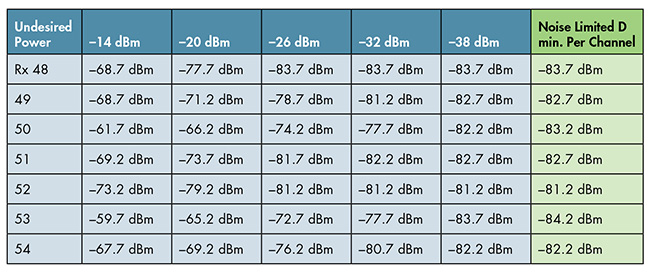Inter-Band RFI: Should Stations Worry?

Charles W. Rhodes
Readers of this column know that while the FCC still does not recognize interference to DTV reception caused by pairs of strong undesired (U) DTV signals, such interference is real. DTV signals on Chs. 30 and 33 generate third-order intermodulation products (IM3) centered in Chs. 27 (2* 30–33) and 36 (2* 33–30).
These IM products fall close to the frequencies of the U signals so that they are “Inter-Band Interferences.” Alas, another set of IM products is also generated. These are of the form 2Fa+Fb and 2Fb + Fa. Using the previous example, Ch. 30 center frequency is 569 MHz, and Ch. 33 is 587 MHz.
2* 569 MHz + 587 MHz = 1725 MHz and 2* 587 + 569 MHz = 1743 MHz. Both are far above the UHF band so they do not present any interference to DTV reception. This is why most technical articles discuss the 2Fa- Fb and 2 Fb-Fa equations and may not take up the other pair.

Fig. 1: Two carriers at the center frequencies of Channel 9 and 11 are shown: Mkr. #1 188.95 MHz (9) and Mkr. #2 200.90 MHz (11).
RF SELECTIVITY
Two strong DTV signals on high VHF band channels present quite a different situation for DTV reception on modern ATSC receivers as these have little RF selectivity. Consider two U signals on Channel 9 (189 MHz center frequency) and Channel 11 (201 MHz center frequency). These generate IM3 centered at 2*189 + 201 = 543 MHz and 2*201 + 198 = 555 MHz in Chs. 32 and 34.
All third-order intermodulation products, (IM3 and Triple Beats), occupy three contiguous channels, so there can be interference to reception on Chs. 30, 31, 32, 33, 34, and 35.
The professional video industry's #1 source for news, trends and product and tech information. Sign up below.

Fig. 2: The IM3 generated by these carriers (Fig. 1) are shown: Mkr. #3 578.85 MHz and Mkr. #4 590.80 MHz. These are of the form 2Fa + Fb and 2Fb + Fa. These fall in the UHF band, between 537 and 633 MHz (Chs. 25 and 41).
I have provided spectrum plots that illustrate this situation. I’ve used unmodulated carriers at the center of Channel 9 (189 MHz) and Channel 11 (201 MHz) in Fig. 1. These signals were passed through a slightly nonlinear amplifier to generate IM3. Fig. 2 shows the IM3 (2Fa + Fb and 2Fb+ Fa) in the UHF band.
We have measured the effect of a pair of high VHF band ATSC signals on Chs. 9 and 11 upon the sensitivity of seven modern ATSC receivers, five of which have a “Silicon Tuner on a Chip.”
Fig. 3 shows the minimum usable desired (D) signal power (Ch. 28) of each receiver when there are two U signals (Chs. 9 and 11) present at the stated power per channel.
Also shown is the noise-limited minimum usable D signal power for each receiver absent interference.
Note that when U equals –38 dBm/ channel, D minimum has reached the receiver’s noise-limited sensitivity for most receivers. Therefore, any U power below –38 dBm would have no effect upon reception. Above –38 dBm/channel, the U signals on these VHF channels reduce the performance of some of these receivers. Above –26 dBm/channel, all receivers are affected. They are all being desensitized by the IM3 from these VHF band signals.

Fig. 3: D minimum Ch. 28 with and without U signals on Chs. 9 and 11.
The D/U ratio for receiver #53 is –45.7 dB per channel. The FCC assumed that modern DTV receivers would have a D/U of –60 dB. The best receiver (#52) closely approached this with D/U equaling –57.7 dB. None met the FCC D/U ratio.
DIFFICULT TO OVERCOME
You have reason to be concerned with inter-band interference because it is difficult to overcome in the field. A 75 ohm high-pass filter rejecting signals in the VHF band would do this, but some viewers would have to switch this filter into a bypass mode whenever a VHF channel is D. So even if such filters were free, VHF broadcasters may be at a competitive disadvantage where inter-band interference is encountered. That is, where the U signal power per channel exceeds –38 dBm.
Another example of inter-band interference, FMI, was described in this column (“A New Kind of FMI on the Horizon,” Jan. 20, 2010). Multiple strong FM radio signals can and do generate second-order distortion products when the front-end of ATSC receivers is overloaded. This problem can be readily and inexpensively fixed with an FM Trap available at many retail stores such as Radio Shack. The FM Trap does not have to be bypassed so the family may remain unaware of its existence assuming that somehow they were told that this simple remedy could restore reception of high VHF-band DTV signals. Alas, any filter to fix inter-band interference to UHF reception may have to be bypassed to receive high VHF band stations.
What else could be done about this inter-band interference? Co-siting of the DTV transmitters lowers the difference in received signal power between stations. With lower D/U ratios, FMI could be avoided.
Charles Rhodes is a consultant in the field of television broadcast technologies and planning. He can be reached via email atcwr@bootit.com.
